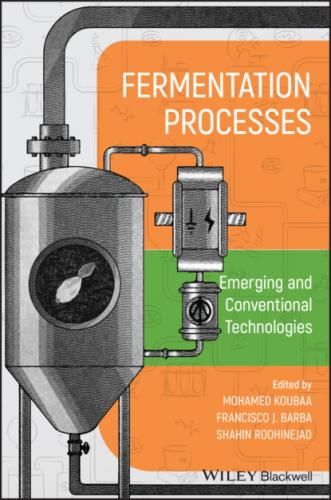Seyedeh‐Sara Hashemi Burn & Wound Healing Research Center, Shiraz University of Medical Science, Shiraz, Iran
Mahdi Irani Department of Food Science and Technology, Ferdowsi University of Mashhad (FUM), Mashhad, Iran
Sucheta Khubber Food Engineering and Nutrition, Center of Innovative and Applied Bioprocessing, Mohali, India
Mohamed Koubaa ESCOM, UTC, EA 4297 TIMR, Compiègne, France
Rita P. Lopes LAQV‐REQUIMTE, Department of Chemistry, University of Aveiro, Aveiro, Portugal
Jose M. Lorenzo Centro Tecnológico de la Carne, Parque Tecnológico de Galicia, Ourense, Spain
Nicolas Louka Faculté des Sciences, Centre d’Analyses et de Recherche, UR TVA, Laboratoire CTA, Université Saint‐Joseph, Beyrouth, Lebanon
Richard G. Maroun Faculté des Sciences, Centre d’Analyses et de Recherche, UR TVA, Laboratoire CTA, Université Saint‐Joseph, Beyrouth, Lebanon
Krystian Marszałek Department of Fruit and Vegetable Product Technology, Prof. Wacław Dąbrowski Institute of Agricultural and Food Biotechnology, Warsaw, Poland
Department of Food Technology and Human Nutrition, Institute of Food Technology and Nutrition, College of Natural Science, University of Rzeszow, Rzeszow, Poland
Francisco J. Marti‐Quijal Faculty of Pharmacy, Preventive Medicine and Public Health, Food Sciences, Toxicology and Forensic Medicine Department, Universitat de València, València, Spain
Maria J. Mota LAQV‐REQUIMTE, Department of Chemistry, University of Aveiro, Aveiro, Portugal
Maryam Nejadmansouri Department of Food Science and Technology, College of Agriculture, Shiraz University, Shiraz, Iran
Mehrdad Niakousari Department of Food Science and Technology, College of Agriculture, Shiraz University, Shiraz, Iran
Alireza Rafati Division of Pharmacology & Pharmaceutical Chemistry, Sarvestan Branch, Islamic Azad University, Sarvestan, Iran
Maryam Razmjooei Department of Food Science and Technology, College of Agriculture, Shiraz University, Shiraz, Iran
Fabienne Remize UMR QualiSud, Université de La Réunion, CIRAD, Université Montpellier, Institut Agro, Université d'Avignon, Sainte Clotilde, France
Shahin Roohinejad Burn & Wound Healing Research Center, Shiraz University of Medical Science, Shiraz, Iran
Dominique Salameh Faculté des Sciences, Centre d’Analyses et de Recherche, UR ‐ EGP, Laboratoire E2D, Université Saint‐Joseph, Beyrouth, Lebanon [email protected] Faculté des Sciences, Centre d’Analyses et de Recherche, UR ‐ EGP, Laboratoire E2D, Université Saint‐Joseph, Beyrouth, Lebanon
Jorge A. Saraiva QOPNA, Chemistry Department, University of Aveiro, Aveiro, Portugal LAQV‐REQUIMTE, Department of Chemistry, University of Aveiro, Aveiro, Portugal
Sylwia Skąpska Department of Fruit and Vegetable Product Technology, Institute of Agricultural and Food Biotechnology, Warsaw, Poland
Justyna Szczepańska Department of Fruit and Vegetable Product Technology, Institute of Agricultural and Food Biotechnology, Warsaw, Poland
Igor Tomasevic Faculty of Agriculture, University of Belgrade, Belgrade, Serbia
Artur Wiktor Faculty of Food Sciences, Department of Food Engineering and Process Management, Warsaw University of Life Sciences (WULS‐SGGW), Warsaw, Poland
Dorota Witrowa‐Rajchert Faculty of Food Sciences, Department of Food Engineering and Process Management, Warsaw University of Life Sciences (WULS‐SGGW), Warsaw, Poland
Łukasz Woźniak Department of Fruit and Vegetable Product Technology, Institute of Agricultural and Food Biotechnology, Warsaw, Poland
Preface
Bioprocesses find many traditional or new applications in the agri‐food, chemical, pharmaceutical, and environmental industries. Enhancing these processes for better production of microbial biomass and/or products has interested many scientists in the last two decades. One of the strategies consists of changing the medium composition or the fermentation parameters (e.g. oxygenation, agitation, temperature, etc.), most of the time via a design of experiment approach. Besides, some emerging technologies (e.g. pulsed electric fields, ultrasounds, high hydrostatic pressure, microwaves, etc.) have shown their efficiency to enhance the fermentation processes. These technologies when applied at high intensities cause cell disintegration and find their applications in bioprocesses, for example, to produce sugar monomers from lignocellulosic biomass. Nonetheless, their application at sublethal levels may induce stress of microorganisms and affect the microbial growth and the formation of the products during fermentation. The beneficial effects of microbial stimulation by emerging technologies include mainly the shortening of the fermentation time, the acceleration of the substrate consumption, and the increase of the microbial biomass.
This book covers the principles of conventional fermentation processes, the major microorganisms used in bioprocesses, their implementation in industrial fermentation processes, the medium condition changes, and the use of emerging technologies for enhancing the fermentation processes. Besides, the mechanisms of action of the above‐mentioned emerging technologies are discussed.
This book is designed to assist scientists working on fermentation processes as well as those working in the food, nutraceutical, pharmaceutical, and beverage industries. The topics covered in this book are suitable for teaching in courses such as bioprocess technology, microbiology, new product development, and food processing.
We gratefully acknowledge the contribution of colleagues from all around the world, the cover designer Mohamed Messaoud, and the professional assistance provided by the staff of Wiley.
Mohamed Koubaa, Francisco J. Barba, and Shahin Roohinejad
1 Introduction to Conventional Fermentation Processes
Mohamed Koubaa
ESCOM, UTC, EA 4297 TIMR, Compiègne, France
1.1 Bioprocesses
Bioprocesses represent all the methods and techniques that use microbial, plant, or animal cells or their components (e.g. enzymes, proteins, genes, etc.) for the production of goods and services (Sindhu et al. 2017). Bioprocess technology is, in fact, an extension of the ancestral techniques used at the time to develop useful products (Kalaichelvan and Pandi 2019). Nowadays, microbial cells are not only used in common processes, such as for the production of alcoholic beverages (e.g. wine, beer, etc.) or dairy products (e.g. yogurt, cheese, etc.), but also to produce a wide diversity of complex molecules. In this sense, bioprocesses find many traditional or new applications in the following industries:
Agri‐food industry: production of animal proteins, amino acids, fermented foods and beverages, vitamins, enzymes, etc.
Chemical industry: production of organic acids, ethanol, solvents, polymers, biogas, etc.
Pharmaceutical industry: production of antibodies, vaccines, hormones, plasmids, steroids, etc.
Environmental industry: decontamination of wastewater, air, and soil; development
